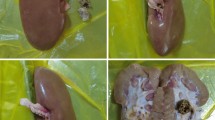Abstract
Purpose
To determine whether lipiodol, which has low thermal conductivity, influences ice ball formation during cryoablation of a lipiodol-mixed-tissue phantom.
Materials and Methods
Lipiodol-mixed-tissue phantoms were created by injecting lipiodol (4–6 ml) into the renal arteries of ex vivo porcine kidneys (lipiodol group). A cryoprobe (CryoHit™ Needle S) with a holder that was set with thermocouples at various positions around the cryoprobe was inserted. After freezing for 300 s, the followings were evaluated: ice ball size on CT, temperature distribution around the cryoprobe, and calculated distances at 0 °C and − 20 °C. Each variable was compared between lipiodol group (n = 6) those obtained in a control group without lipiodol injection (n = 6).
Results
Mean ice ball diameter (width/length) on CT was 22.1 ± 2.3/22.9 ± 2.3 mm in the lipiodol group and 21.6 ± 0.7/22.2 ± 1.3 mm in the control group. Mean cryoprobe temperature was − 118 ± 3.0 °C in the lipiodol group and − 117 ± 2.6 °C in the control group. In both groups, temperature at the 3 mm thermocouple reached approximately − 50 °C and was < 0 °C within ~ 10 mm of the cryoprobe. Temperature of 0/− 20 °C occurred at a mean distance from the cryoprobe of 11.1 ± 0.5/6.9 ± 0.4 mm in the lipiodol group and 11.0 ± 0.2/6.9 ± 0.2 mm in the control group. There was no significant difference in any variable between the groups.
Conclusion
The inclusion of lipiodol in a tissue phantom had no negative effects on ice ball formation that were related to thermal conductivity.





Similar content being viewed by others
References
Schmit GD, Thompson RH, Kurup AN, et al. Usefulness of R.E.N.A.L nephrometry scoring system for predicting outcomes and complications of percutaneous ablation of 751 renal tumors. J Urol. 2013;189(1):30–5.
Uppot RN, Silverman SG, Zagoria RJ, et al. Imaging-guided percutaneous ablation of renal cell carcinoma: a primer of how we do it. AJR Am J Roentgenol. 2009;192(6):1558–70.
Lim E, Kumar S, Seager M, et al. Outcomes of renal tumors treated by image-guided percutaneous cryoablation: immediate and 3- and 5-year outcomes at a regional center. AJR Am J Roentgenol. 2020;215(1):242–7.
Venkatesan AM, Wood BJ, Gervais DA. Percutaneous ablation in the kidney. Radiology. 2011;261(2):375–91.
Michimoto K, Shimizu K, Kameoka Y, et al. Transcatheter arterial embolization with a mixture of absolute ethanol and iodized oil for poorly visualized endophytic renal masses prior to ct-guided percutaneous cryoablation. Cardiovasc Intervent Radiol. 2016;39(11):1589–94.
Miyazaki M, Iguchi T, Takaki H, et al. Ablation protocols and ancillary procedures in tumor ablation therapy: consensus from Japanese experts. Japanese J Radiol. 2016;34(9):647–56.
Hongo F, Yamada Y, Ueda T, et al. Preoperative lipiodol marking and its role on survival and complication rates of CT-guided cryoablation for small renal masses. BMC Urol. 2017;17(1):10.
Gunn AJ, Mullenbach BJ, Poundstone MM, et al. Transarterial embolization of renal cell carcinoma as an adjunctive therapy prior to cryoablation: a propensity score matching analysis. Diagn Interv Radiol (Ankara, Turkey). 2018;24(6):357–63.
Woodrum DA, Atwell TD, Farrell MA, et al. Role of intraarterial embolization before cryoablation of large renal tumors: a pilot study. J Vasc Interv Radiol: JVIR. 2010;21(6):930–6.
Ahmed M, Solbiati L, Brace CL, et al. Image-guided tumor ablation: standardization of terminology and reporting criteria–a 10-year update. J Vasc Interv Radiol: JVIR. 2014;25(11):1691-705.e4.
Yoshikawa T, Miura H, Hirota T, et al. Fundamental evaluation of thermophysical properties of lipiodol associated with cryoablation: freezing experiments using lipiodol phantom. Cardiovasc Interv Radiol. 2020;43(3):514–9.
Kajiwara K, Yoshimatsu R, Nishimori M, et al. Efficacy of arterial infusion of iodized oil on CT-guided cryoablation for renal cell carcinoma. Minimally invasive therapy & allied technologies : MITAT : official. Journal of the Society for Minimally Invasive Therapy. 2020. https://doi.org/10.1080/13645706.2020.1734622.
Shurrab M, Wang H, Kubo N, et al. The cooling performance of a cryoprobe: establishing guidelines for the safety margins in cryosurgery. Int J Refrig. 2016;67:308–18.
Nakatsuka S, Yashiro H, Inoue M, et al. On freeze-thaw sequence of vital organ of assuming the cryoablation for malignant lung tumors by using cryoprobe as heat source. Cryobiology. 2010;61(3):317–26.
Young JL, Khanifar E, Narula N, et al. Optimal freeze cycle length for renal cryotherapy. J Urol. 2011;186(1):283–8.
Ahmed M. Image-guided tumor ablation: standardization of terminology and reporting criteria–a 10-year update: supplement to the consensus document. J Vasc Interv Radiol: JVIR. 2014;25(11):1706–8.
Hoffmann NE, Bischof JC. The cryobiology of cryosurgical injury. Urology. 2002;60(2 Suppl 1):40–9.
Arnold MM, Kreel L, Wallace AC, et al. Distribution of Lipiodol and evidence for tumor necrosis in hepatocellular carcinoma. Am J Clin Pathol. 1992;97(3):405–10.
Takamatsu H, Zawlodzka S. Contribution of extracellular ice formation and the solution effects to the freezing injury of PC-3 cells suspended in NaCl solutions. Cryobiology. 2006;53(1):1–11.
Ishiguro H, Rubinsky B. Mechanical interactions between ice crystals and red blood cells during directional solidification. Cryobiology. 1994;31(5):483–500.
Funding
This study was not supported by any funding.
Author information
Authors and Affiliations
Corresponding author
Ethics declarations
Conflict of interest
The authors declare that they have no conflict of interest.
Ethical Approval
All procedures performed in studies involving animals were in accordance with the ethical standards of the institution or practice at which the studies were conducted.
Informed Consent
For this type of study informed consent is not required.
Consent of Publication
For this type of study consent for publication is not required.
Additional information
Publisher's Note
Springer Nature remains neutral with regard to jurisdictional claims in published maps and institutional affiliations.
Rights and permissions
About this article
Cite this article
Yamashita, M., Miura, H., Ohara, Y. et al. Evaluation of Temperature Distribution Around the Probe in Cryoablation of Lipiodol-Mixed-Tissue Phantom. Cardiovasc Intervent Radiol 44, 489–495 (2021). https://doi.org/10.1007/s00270-020-02710-3
Received:
Accepted:
Published:
Issue Date:
DOI: https://doi.org/10.1007/s00270-020-02710-3




